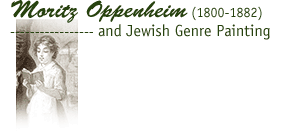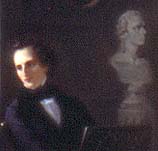|

One of the most successful
Jewish artists in 19th century Europe, Moritz Oppenheim (Germany, 1800-1882)
painted in several different styles during the course of his long life.
Early on, during a four-year stay in Rome and Naples, he depicted scenes
from the Hebrew Bible and the New Testament. Upon returning to Frankfurt,
he focused on portraiture in the traditional nineteenth-century bourgeois
style, in which anecdotal elements showed the subject's demeanor and portrayed
aspects of his personality. His most loyal patrons were the Rothschilds,
the family of financiers and philanthropists, patrons of the arts and
sciences who greatly contributed to Jewish causes; Oppenheim became known
as "painter of the Rothschilds" and — on account
of his financial success — as "the Rothschild
of the painters." The private portraits that the Rothschilds commissioned
between the 1820s and 1850s, gradually became more formal. In addition
to portraits, pencil sketches and oils, Oppenheim produced a famous series
of Jewish genre paintings.
The term "genre" is
used to describe an artwork that depicts a scene from everyday life. It
refers to art from many different periods and many different places. The
Dutch and Flemish painters were masters of this style and transformed
it into the realm of acceptable, and even the great. But from antiquity
until the middle ages, genre painting was looked down upon as not sufficiently
serious because its subject matter was not allegorical, religious, or
historical. Even today, genre painting - while delightful, entertaining
and easy to relate to - is not considered high status.
During
the nineteenth century, genre painting in Europe became popular among
the bourgeoisie; their tastes were conventional and they were comfortable
hanging on their walls that art which presented aspects of real life to
which they could relate.
In the Jewish
community, genre painting was especially popular among emancipated Jews.
As restrictions on
Jewish activity was lifted and Jews began to live more peaceably among
their gentile neighbors, many chose to leave their religious tradition
and customs behind. Jewish genre art, with its depictions of Jewish celebrations
and worship, provided these Jews with a reminder of their religious heritage
and satisfied a craving for nostalgia. As middle-class Jews developed
a growing appreciation of art — buying and putting
it on their walls — they sought art with a "Jewish
motif," for lack of a Jewish painting tradition. Newly integrated
in European society, they were not yet familiar with the treasure troves
of art that could be viewed in museums and churches.

Felix
Mendelssohn-
Bartholdy plays for Goethe, 1864.
enlargement
|
Oppenheim's series
Pictures of Traditional Jewish Family Life, which includes 20 paintings,
is perhaps the most well-known example of Jewish genre painting. Published
in an album in 1865, Bilder aus dem altjuedischen Familienleben
appeared a year later in the United States as Family Scenes from Jewish
Life of Former Days. Realistic yet tinged with romanticism, these
scenes show excellent composition, and real skill in the grouping of the
dramatis personae; they have been frequently reproduced to illustrate
books on Jewish topics. Oppenheim also produced a series of large pictures
on confrontations between Jews and Christians, e.g., Moses Mendelssohn
and Lavater, Mendelssohn and King Frederick the Great. [*]
Beginning with
Rembrandt, Jewish features were seriously rendered instead of caricatured,
and the nineteenth-century Jewish painters such as Oppenheim, took this
a step farther with both portraiture and genre painting.
|
Ismar
Schorsch. "Art as Social History: Oppenheim and the German Jewish
Vision of Emancipation." In: Moritz Oppenheim (Catalog of
an exhibition at the Israel Museum, Fall, 1983) (Jerusalem: Ben-Zvi
Printing Enterprises, Ltd., 1983).
Cecil
Roth, ed. Jewish Art: An Illustrated History (New York: McGraw
Hill Book Company, Inc., 1961).
Alfred
Werner. "Oppenheim and Kaufmann: Fine Genre Painters." In Families
& Feasts: Paintings by Moritz Daniel Oppenheim and Isidor Kaufmann
(catalog of an exhibition at Yeshiva University Museum April 24
- June 19, 1977).
Gabrielle
Sed-Rajna. Jewish Art (New York: Harry N. Abrams, Inc., 1997).
Weber,
Annette. "Moritz Daniel Oppenheim and the Rothschilds" in Heuberger,
Georg and Anton Merk, eds. Moritz Daniel Oppenheim: Jewish Identity
in 19th Century Art (Catalog of an exhibition at the J?disches
Museum, Frankfurt, December 16 1999-April 2, 2000). Copyright ?
1999 Wienand Verlag, J?disches Museum, Frankfurt.
Encyclopedia
Judaica (Jerusalem: Keter Publishing House, Ltd., 1971).
|
|
[*]
Moses Mendelssohn (1729-1786), was a philosopher of the German Enlightenment
in the pre-Kantian period and spiritual leader of German Jewry; Johann
Caspar Lavater was a Lutheran theologian from Berlin. [back] |
|



